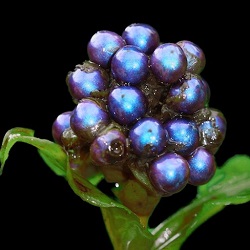A rainforest berry that remains shiny and looking fresh for over 100 years has broken the rules on light and colour. The cells on the fruit are made of cellulose, like paper, but are naturally patterned so that they reflect light in all the colours of the rainbow. What’s more, they are now inspiring a next generation of bright ‘metallic’* edible pigments made entirely from paper instead of controversial E numbers.
The unusually beautiful colouring in the tiny dry fruit is similar to the brilliant colours seen in peacock feathers and butterflies. It relies on patterning on a very small scale, similar to the wavelength of light. That means it doesn’t fade and it doesn’t include any other chemicals found in other dyes. Now, a technique to replicate this in the lab has been developed, which allows us to improve further on this fantastic material, and use it as a pigment ourselves.
There are other rainforest plants that use the same trick to give their leaves an extra special blue shine. However, researchers were shocked to realise that this fruit has another special feature. Light can be given a twist to the left or the right, a fact we now use in 3D cinema glasses which let you see a different direction twist through each eye. Thanks to a quirk of the structure, all the other shiny plants only show colour in the left eye of cinema glasses, but this fruit can be seen through both kinds of filters. In fact, this fruit seems to be alone in the natural world in having this opposite handed structure.
How and why this remarkable adaptation came about is the mystery we are trying to solve, through combining skills in physics, chemistry, biology and materials science. This exciting research promises to let us into the secrets of materials, light and our own brilliantly coloured future.
*the colours are so brightly reflective, they look metallic, although there is no metal in them.
Rox Middleton
NanoDTC PhD Student Cohort 2013
Department of Chemistry
Cover Image- Vignolini et al.

